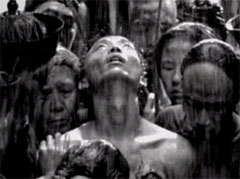
| HOME |
| NERVE |
| REVIEWS |
| ARCHIVE |
| EVENTS |
| LINKS |
| ABOUT US |
| CONTRIBUTORS |
| BACK ISSUES |
| CONTACT US |
 The
Agony & The Ecstasy
The
Agony & The Ecstasy
Chen Chie-jen, Sigalit Landau, Marzia Migliora & Elisa Sighicelli
FACT Centre, Wood Street
24th June – 14th August 2005
Reviewed by Adam Ford
In the unspoken language of the media, ‘extreme’ always means ‘very bad’. ‘Extremists’ are the people who threaten our safety and have ‘crazy’ views that you shouldn’t trouble your pretty head over. In entertainment, a daft recycled romantic comedy tops the box office almost every week, and bland pop groups sell by the shedload whilst record companies threaten to drop anyone who has an original idea in their heads. After all, the outside world is hard enough, so who wants to be challenged in their leisure time? Well I do for one, and hopefully you do too.
As should be clear from the title, this exhibition deals entirely in extremes of emotion. I saw two people turn away in disgust, but I saw many more who had been drawn like moths to the proverbial flame.
Without a doubt, the most shocking exhibit is Chen Chie-jen’s ‘Lingchi – Echoes of a Historical Photograph’. Depicting the ‘death by a thousand cuts’ style of execution used in China until 1905, we apparently see a man being dosed with opium before having his chest carved open and his limbs severed by his executioner. Set in an abandoned Taiwanese factory, the triptych (or three-panelled) monstrosity is highly symbolic, reminding us of our own lives and our own deaths. There are parallels with paintings of the Christian Passion in the tortured yet almost sexual expressions that dance across the victim’s face. It’s not exactly easy on the eye, but it’s definitely worth the effort if you can make it through to the end.
Sigalit Landau’s ‘Barbed Hula’ is hardly any less unnerving. A naked female dancer does a hula dance on the Israeli seashore – which the artist points out is the “only calm and natural border” the country has. But the hula hoop is indeed barbed, and the gyrations of the dancer’s hips are causing deep lacerations around her waist, so the viewer is attracted and repelled by every circle and every circular movement. Again, there seem to be layers of religious and political symbolism here, though each person will have their own pet neuroses and preoccupations brought to mind.
Chie-jen and Landau’s exhibits are certainly hard acts to follow, so somehow Marzia Migliora & Elisa Sighicelli’s ‘Pitfalls’ doesn’t quite seem to fit the bill. The piece is apparently based on an 18th century encyclopaedia, and the viewer is taken through an stunningly beautiful animated engraved 3D ‘wood’ where a ‘pitfall’ is constantly on the move. Unfortunately, any metaphor is lost because viewers can’t see the hole and it just seems as though they are lost in a wood. That’s scarily familiar to those of us who are spatially dyslexic, but it doesn’t exactly illuminate the darkest recesses of the soul.
Despite the disappointment, this is an exhibition of significance and
invention which is a very challenging way to spend your leisure time.
This is a good thing! You could switch the telly on, but it will only
be the same old same old. You won’t remember tonight’s Hollyoaks
on your deathbed, but you will certainly remember the agony and the ecstasy.
"Does the image fit the picture?" by John Owen
Facing issues of French colonial power and rule in Indochina then and
now the image used to make a short movie shows the destruction and deconstruction
of a human being. Publicly humiliated, stripped of hair and body parts
literally hacked off by special Spanish Inquisition style torture implements,
the gruesome scene is enacted in a slow style that implicates the viewer
in the torture. The tone shading and effect of night and day in black
and white good versus evil, while a triptych of screens emphasises the
separation of the body and Christ like execution, cut to empty factories
ruined lives ruined workers all dying the slow death of silent cancers,
another exhibition in the Venice Biennale by the same artist explores
this theme.
The characters used are in medieval dress and ex-textile employees. The
gruesome prisons of the past resemble the empty spaces as business is
relocated to cheaper parts of mainland China. The death is prolonged with
opium given to the victim whose crime upset the community, smeared all
over his body as emasculation is carried out. Perhaps this is a metaphor
for the subjugation of China by the British and French through the opium
trade. Once the workshop of the world like Britain slow death awaits its
inhabitants. French academic Georges Batailles book “Tears of Eros”
was the inspiration. A French soldier’s secret photograph captured
the moment forever for us to ponder. It was all the rage in its day which
perhaps says more than we like to know about ourselves.